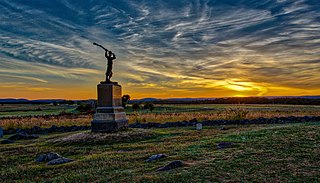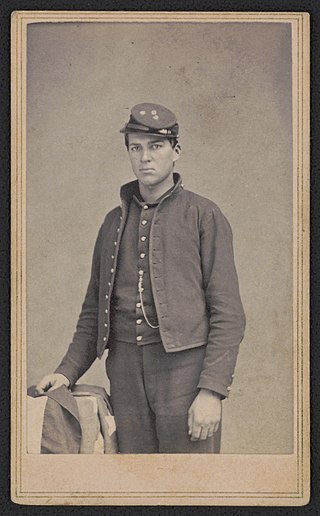
The 71st Regiment, Pennsylvania Volunteer Infantry was an infantry regiment of the Union Army that participated in the American Civil War.
The 139th Pennsylvania was an infantry regiment in the Union Army during the American Civil War.

The 23rd Pennsylvania Volunteer Infantry was an infantry regiment that fought in the Union Army during the American Civil War. Known for its colorful uniforms based upon the popular French Zouave style, the regiment served in the Eastern Theater.
The Philadelphia Brigade was a Union Army brigade that served in the American Civil War. It was raised primarily in the city of Philadelphia, Pennsylvania, with the exception of the 106th regiment which contained men from Lycoming and Bradford counties.

The 72nd Pennsylvania Infantry was a volunteer infantry regiment which served in the Union Army during the American Civil War. It was part of the famous Philadelphia Brigade.
The 116th Pennsylvania Infantry was a volunteer infantry regiment in the Union Army during the American Civil War. It formed a part of the Irish Brigade.

The 3rd Pennsylvania Reserve Regiment, also known as the 32nd Pennsylvania Volunteer Infantry Regiment, was an infantry regiment that served in the Union Army during the American Civil War. It was part of the 2nd Brigade of the Pennsylvania Reserves division.

The 4th Pennsylvania Reserve Regiment, also known as the 33rd Pennsylvania Volunteer Infantry Regiment, was an infantry regiment that served in the Union Army during the American Civil War. It was a part of the famed Pennsylvania Reserves in the Army of the Potomac for much of the early part of the war and served in the Eastern Theater in several important battles, including Antietam and Fredericksburg.

The 118th Pennsylvania Regiment was a volunteer infantry regiment in the Union Army during the American Civil War. They participated in several major conflicts during the war including the Battle of Gettysburg, Siege of Petersburg, and escorted the truce flag of Robert E. Lee at the Battle of Five Forks. The regiment was led by Colonel Charles Prevost until he was seriously injured at the Battle of Shepherdstown in which Lieutenant-Colonel James Gwyn assumed command until the end of the war.

The 90th Regiment, Pennsylvania Volunteer Infantry was a volunteer infantry regiment which served in the Union Army during the American Civil War. They wore chasseur-style uniforms, which each consisted of a dark blue habit veste with white trim, baggy sky-blue trousers and a dark blue kepi. The buttons on the habit veste were unique to the 90th Pennsylvania. They were the only Union regiment in the entire war to have a specific button design.
The 74th Pennsylvania Volunteer Infantry was an infantry regiment which served in the Union Army during the American Civil War. It was one of many all-German regiments in the army, most notably in the XI Corps of the Army of the Potomac. Its combat record was marred by the perceived poor performance of the entire corps at Chancellorsville and Gettysburg, when parts of the corps routed during Confederate attacks.
The 142nd Pennsylvania Volunteer Infantry was a volunteer infantry regiment that fought in the Union Army during the American Civil War. The regiment primarily served in the Army of the Potomac in the Eastern Theater and was heavily engaged in the first day of fighting at Gettysburg.
The Thirteenth Pennsylvania Reserve Regiment, also known as the 42nd Pennsylvania Volunteer Infantry, the 1st Pennsylvania Rifles, Kane's Rifles, or simply the "Bucktails," was a volunteer infantry regiment that served in the Union Army during the American Civil War. It was a part of the famed Pennsylvania Reserve division in the Army of the Potomac for much of the early and middle parts of the war, and served in the Eastern Theater in a number of important battles, including Antietam, Fredericksburg, and Gettysburg.

The 2nd Regiment Massachusetts Volunteer Infantry was an infantry regiment in the Union Army during the American Civil War. Major George H. Gordon, a West Point graduate and veteran of the Mexican–American War, organized the unit's recruitment and formation. The 2nd Massachusetts was trained at Camp Andrew in West Roxbury, Massachusetts on the site of the former Transcendentalist utopian community, Brook Farm. Roughly half the regiment was mustered in on May 18, 1861 and the remainder on May 25, 1861 for a term of three years. The regiment saw extensive combat as part of the Army of the Potomac particularly during the Battle of Antietam and the Battle of Gettysburg.

The 61st New York Infantry Regiment, also known as the "Astor Regiment", was an infantry regiment of the Union Army during the American Civil War.

The 80th New York Infantry Regiment, the "Twentieth New York State Militia", "Ulster Guard", was an infantry regiment of the Union Army during the American Civil War.
The 2nd Delaware Infantry Regiment was an infantry regiment in the Union Army during the American Civil War.

The 2nd Pennsylvania Reserve Regiment also known as the 31st Pennsylvania Volunteer Infantry was an infantry regiment that served in the Union Army as part of the Pennsylvania Reserves infantry division during the American Civil War.
The 27th Pennsylvania Volunteer Infantry was an infantry regiment that served in the Union Army during the American Civil War.

The 2nd New York Cavalry Regiment, officially known as the 2nd Regiment, New York Volunteer Cavalry, was a unit of the Union Army during the American Civil War. It served with the Army of the Potomac and fought in Stoneman's 1863 raid, the Wilson–Kautz Raid, and the Battle of Appomattox Station.








